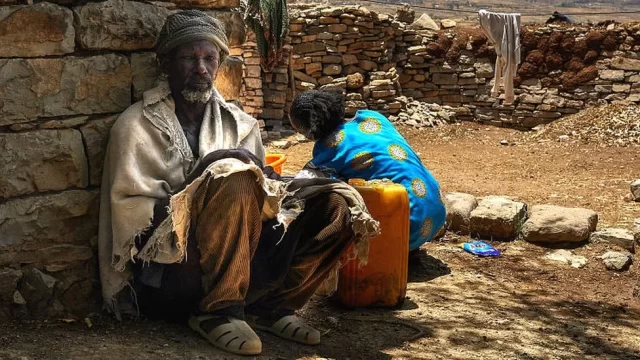Famine is stalking parts of Ethiopia. The epicentre is in the northern Tigray region.
Reports of hundreds of children dying of starvation are trickling in from remote areas.
What is particularly disturbing is that this crisis is unfolding so early in the season. The main harvest in Tigray and neighbouring Amhara is in November, and this is the time of year when food should be most plentiful.
But the federal government in Addis Ababa denies that a famine is imminent, and says it is working to provide aid.
Veterans of relief operations, however, are comparing the crisis to the situation in 1984, when a combination of drought and war caused a famine that killed up to a million people.
The UN’s Office for the Coordination of Humanitarian Affairs (Ocha) estimates that more than 20 million Ethiopians are in need of food aid, of whom about a third are receiving assistance. In Tigray, the picture is especially alarming.
Last month, the Tigrayan authorities said that 3.5 million people, more than half the region’s population, needed aid for the entire year.
About two-thirds were farmers, and one-third were people displaced by the war who could not yet return home. Another 1.7 million people would need aid at some point during 2024, Ocha said.
The main reason for the calamity is that the ravages of war reduced Tigray to extreme poverty.
The fighting was between Ethiopian government and allied forces on the one hand, and Tigrayan forces on the other, following a massive fall-out between the federal and regional governments.
It lasted for two years from November 2020, and saw an extraordinary level of destruction.
Though there were official denials, soldiers were accused of stealing or burning food and farms, slaughtering livestock, including plough oxen, and ransacking and vandalising water systems.
More than 1.4 million people were forcibly displaced, especially from the more fertile western parts of Tigray, which were taken over by the neighbouring Amhara region.

GETTY IMAGES
Most farmers in Tigray have small plots of land and made ends meet because young people were employed in towns or as seasonal workers on commercial farms.
But the region’s economy was devastated: factories were looted or burned, tourism was reduced to zero and productive farmland seized.
On top of that came a siege. Trade stopped. Only a trickle of humanitarian aid was permitted.
The banks were closed. Farmers could not get loans. Welfare payments stopped, except for a few brave people who smuggled in cash.
Salaries for about 130,000 civil servants were not paid and 90,000 pensioners could not collect their pensions. People used up meagre savings and sold precious assets. Inflation has pushed food prices out of reach.
After a ceasefire was signed in November 2022, the siege was loosened. But there was very little reconstruction. There is still little trade and employment.
The last straw was that the rains failed.
A total of 36 of Tigray’s 97 districts were badly affected, with rainfall as low as a third of what is normally expected.
Meanwhile, drought and armed conflict in next-door Amhara means that there are escalating food needs there too.
In southern Ethiopia, repeated droughts have brought pastoralist communities to the brink of destitution.
In October, a joint report from USAid’s famine early warning system and the UN World Food Programme sounded the alarm.
On the five-level scale of food insecurity, from phase one (normal) to five (catastrophe or famine), they predicted a fast-expanding number of people, mostly in Tigray but also elsewhere, in phase four (emergency) by early 2024.
One step short of outright famine, this level of hunger is still bad enough for children in the poorest families to die of starvation and disease.
The report contained a disturbing line: “The gradual resumption of food assistance deliveries by early 2024 is expected to moderate the size of kilocalorie deficits among beneficiaries, but not yet at a scale and frequency that would prevent high levels of food insecurity.”
In polite language, the authors were telling their organisations that they needed to step up aid assistance rapidly and massively.

GETTY IMAGES
The background to this is that last year, aid staff uncovered massive schemes of stealing food aid.
It was first revealed in Tigray, where both federal and Tigrayan officials were accused of diverting aid trucks to grain mills and selling flour on the market.
During the war, Ethiopian soldiers had been regularly observed by aid workers taking aid food for their daily rations, and in one instance entire divisions of allied Eritrean troops were said to have had backpacks filled with Unicef-supplied formulae for young children.
Little of this was made public at the time.
Last year local officials were caught stealing food in Tigray – 186 culprits were identified – and families were required to donate 2kg of their 15kg monthly ration to Tigrayan forces, on the argument that each had a soldier who needed to be fed.
The problem of theft is nationwide.
The investigation reports have not been made public but one was said to describe “a co-ordinated and criminal scheme” covering seven of Ethiopia’s nine regions. A diplomat was quoted as saying that flour made from donated wheat was being exported to Kenya and Somalia.
Last May, USAid and the WFP suspended all food aid in the country while they overhauled the system. Small-scale distributions were piloted in November, and are being scaled up, but only gradually.
Meanwhile, poor villagers sold their last goats or ate their seeds. In some places children starved. Even after the warnings were sounded in the October report, aid donors did not accelerate their plans.
The reason for the lack of urgency was that the Ethiopian government insisted all was fine.
Prime Minister Abiy Ahmed proudly announced that Ethiopia had become not only self-sufficient in wheat but was exporting it too.
Last month a spokesman denied a risk of famine in Tigray, before partly backtracking and admitting to a problem of “recurrent droughts”.
Abiy is spending $10bn (£9.2bn) on a new national palace and more than $1bn on the military. The US, the biggest donor by far, is cutting back on aid to Ethiopia.
Forty years ago, it took the intrepid journalism of the BBC’s Michael Buerk and Mohamed Amin to break through official silence and stir the conscience of the world.
Many Ethiopians are hoping that the current food crisis will ease, not worsen.
But as the UN emergency relief head, Martin Griffiths, has said, “time is of the essence” if lives are to be saved.







